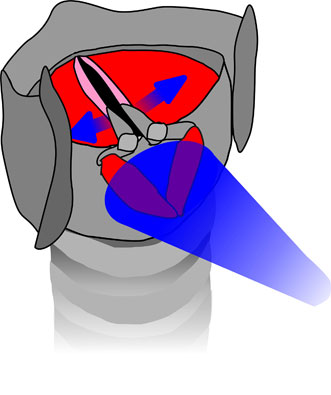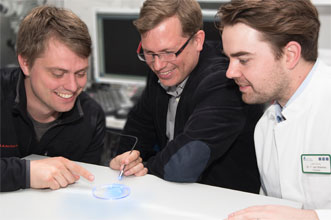Optogenetics techniques could be exploited to treat laryngeal paralysis, a condition that interferes with speaking, swallowing and breathing.
Researchers at the University of Bonn have made individual larynx muscles in mice responsive to light by injecting them with the protein Channelrhodopsin-2. They found that 50ms light pulses at 30 Hz triggered the largest contractions.

The rear laryngeal muscles are genetically modified so that they open the air passage when exposed to light. Courtesy of Dr. Tobias Bruegmann/University of Bonn.
In 2010, the researchers used the same method to stimulate the hearts of mice. However, laryngeal muscles are part of the skeletal musculature, "and skeletal muscles follow different rules," said Dr. Philipp Sasse, head of the current study.
For instance, each fiber in a skeletal muscle can contract separately, which allows precise control of movements and muscle strength. In addition, unlike heart muscles, skeletal muscles can perform static contractions if they are repeatedly stimulated at high frequency.
"For the first time, we have been able to show that light pulses can also create static contractions," said Dr. Tobias Bruegmann, the study's first author. "Depending on where we point the light beam, we can also stimulate individual muscle groups – exactly the same way the body does it through the nerves."
As a result, this method may point the way to new treatment approaches for laryngeal paralysis. The condition can occur after thyroid operations, and during other pathological processes that affect the laryngeal nerves.
The larynx plays an important role in speaking and swallowing, but most importantly in breathing: The muscles of the larynx pull the vocal cords apart so that air can flow into the lungs. In the event of complete paralysis, the patient can no longer breathe.

Dr. Tobias Bruegmann, Dr. Philipp Sasse and Dr. Tobias van Bremen use an optical fiber to demonstrate the functional principle. Courtesy of Claudia Siebenhuener/University Hospital Bonn.
Electrical stimulators have little effect in restoring larynx function "because there are different muscles with opposite function close together," said Dr. Tobias van Bremen, an ear, nose and throat doctor at University Hospital Bonn and one of the co-authors of the study. "It is almost impossible to stimulate these muscles individually using electrodes."
The optogenetic method, on the other hand, can be used with more precision. Several technical hurdles must be overcome before it becomes clinically viable, however, such as delivering Channelrhodopsin into the larynx musculature. The researchers are now testing gene transfer techniques and also optical stimulators.
The research was published in Nature Communications (doi: 10.1038/ncomms8153).
For more information, visit www3.uni-bonn.de.